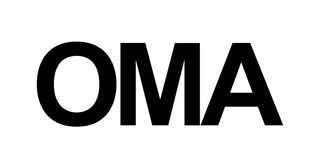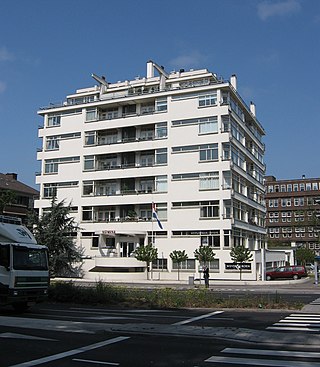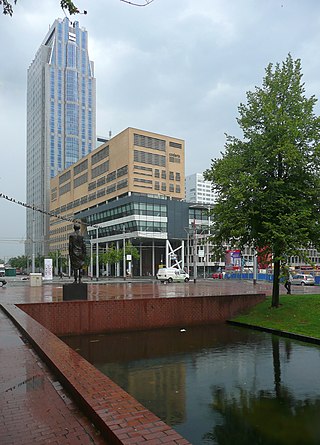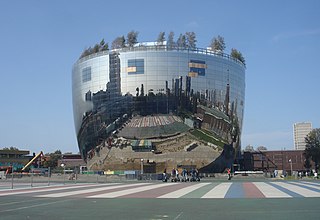
Rotterdam is the second-largest city in the Netherlands after the national capital of Amsterdam. It is in the province of South Holland, part of the North Sea mouth of the Rhine–Meuse–Scheldt delta, via the "New Meuse" inland shipping channel, dug to connect to the Meuse at first and now to the Rhine.
The year 1977 in architecture involved some significant architectural events and new buildings.

The Art Gallery of Ontario is an art museum in Toronto, Ontario, Canada, located in the Grange Park neighbourhood of downtown Toronto, on Dundas Street West. The building complex takes up 45,000 square metres (480,000 sq ft) of physical space, making it one of the largest art museums in North America and the second-largest art museum in Toronto, after the Royal Ontario Museum. In addition to exhibition spaces, the museum also houses an artist-in-residence office and studio, dining facilities, event spaces, gift shop, library and archives, theatre and lecture hall, research centre, and a workshop.

The Ward W. Willits House is a home designed by architect Frank Lloyd Wright. Designed in 1901, the Willits house is considered one of the first of the great Prairie School houses. Built in the Chicago suburb of Highland Park, Illinois, the house presents a symmetrical facade to the street. One of the more interesting points about the structure is Wright's ability to seamlessly combine architecture with nature. The plan is a cruciate with four wings extending out from a central fireplace. In addition to stained-glass windows and wooden screens that divide rooms, Wright also designed the furniture for the house.

MVRDV is a Rotterdam, Netherlands-based architecture and urban design practice founded in 1993, with additional offices in Berlin, New York, Paris, and Shanghai. It is currently regarded as one of the world's finest architecture firms. MVRDV is an acronym of the founding members' surnames: Winy Maas, Jacob van Rijs, and Nathalie de Vries.

The Office for Metropolitan Architecture (OMA) is an international architectural firm with offices in Rotterdam, New York, Hong Kong, Doha, and Australia. The firm is currently led by eight partners - Rem Koolhaas, Reinier de Graaf, Ellen van Loon, Shohei Shigematsu, Iyad Alsaka, Chris van Duijn, Jason Long, and managing partner and architect David Gianotten.

Municipal Museum Boijmans Van Beuningen is an art museum in Rotterdam in the Netherlands. The name of the museum is derived from the two most important collectors of Frans Jacob Otto Boijmans and Daniël George van Beuningen. It is located at the Museumpark in the district Rotterdam Centrum, close to the Kunsthal and the Natural History Museum.
Abel Joseph "Jack" Diamond, was a South Africa-born Canadian architect. Diamond arrived in Canada in 1964 for the University of Toronto. In 1974, he established his architectural practice, A.J. Diamond Architects. This practice evolved into Diamond Schmitt Architects.

Piet Blom was a Dutch architect best known for his designs of the Bastille (1964-1969), a restaurant and student facility at the University of Twente, Enschede, the housing project Kasbah in Hengelo (1969-1973), and the Cube Houses built in Helmond (1972-1976) and in Rotterdam (1978-1984).

West 8 is an urban planning and landscape architecture firm founded by Adriaan Geuze and Paul van Beek in Rotterdam, Netherlands in 1987. It is known for its contemporary designs and innovative solutions to urban planning problems using lighting, metal structures, and color. Van Beek is no longer part of the firm.

Nieuwe Zakelijkheid, translated as New Objectivity or New Pragmatism, is a Dutch period of modernist architecture that started in the 1920s and continued into the 1930s. The term is also used to denote a (brief) period in art and literature. Related to and descended from the German movement Neue Sachlichkeit, Nieuwe Zakelijkheid is characterized by angular shapes and designs that are generally free of ornamentation and decoration. The architecture is based on functional considerations and often included open layouts that allowed spaces to be used with flexibility. Sliding doors were included in some of the designs.
Atelier Kempe Thill is an architectural firm that includes Oliver Thill and André Kempe, originally from East Germany who graduated of TU Dresden. They are now based in Rotterdam, Netherlands.

The former Van Nelle Factory on the Schie in Rotterdam, is considered a prime example of the International Style based upon constructivist architecture. It has been a designated UNESCO World Heritage Site since 2014. Soon after it was built, prominent architects described the factory as "the most beautiful spectacle of the modern age" and "a poem in steel and glass".

Blijdorp is a neighbourhood in northern Rotterdam and is part of the borough Noord. The neighbourhood has around 9500 inhabitants.

Codarts University for the Arts is a Dutch vocational university in Rotterdam that teaches music, dance and circus. It was established in its present location in 2000.

Theater 't Speelhuis was a theatre in Helmond, the Netherlands.

The Rufer House at Schließmanngasse 11 in Vienna, was designed by architect Adolf Loos in 1922 for Josef Rufer and Marie Rufer. It is considered to be the first example of Raumplan style. Raumplan was very different from its predecessor Free Plan style in its internal spatial organization. While not as well known as some other houses designed by Loos, the Rufer House set the precedent for his later designs.
This article lists some of the events that took place in the Netherlands in 2011.

Berend Strik is a Dutch visual artist working and living in Amsterdam.

Depot Boijmans Van Beuningen is an art depot of Museum Boijmans Van Beuningen in Rotterdam. It is the first publicly accessible art depot in the world.































